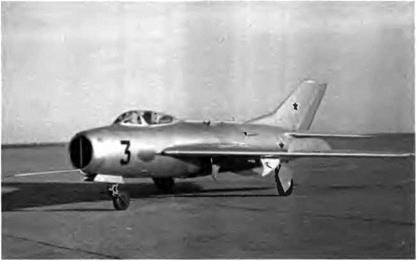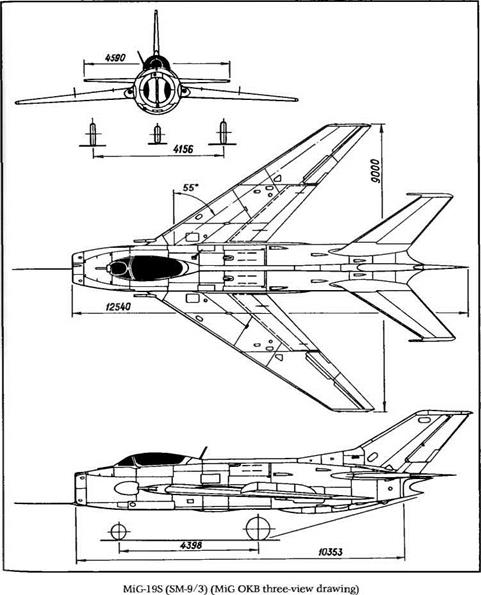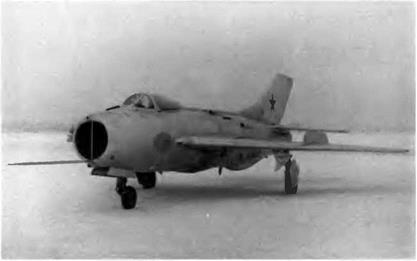MiG 19S / SM-9/2 and SM-9/3
Development of the next two prototypes, the SM-9/2 and SM-9/3, was intended to improve the handling of the MiG-19 with a stabilator or slab tailplane. While satisfactory on the whole, tests of the SM-9/1 uncovered some inadequacies, especially a decreasing linear acceleration at supersonic speeds The answer was to design a linkage for the stabilator control that would generate acceptable control column forces and prevent the pilot from imparting a longitudinal swing to the aircraft through the whole range of speeds and altitudes. Test flights made by G. A. Sedov, К. K. Kokkinaki, and V. A. Nefyedov demonstrated the necessity of such a device. On several occasions the SM-9/2 reached very dangerous flight regimes, mainly when the aircraft started to swing and the pilot’s use of the stabilator did nothing but increase the swing rate.
The SM-9/2 and SM-9/3 were built in 1954, one after the other. They differed from the SM-9/1 in their slab tailplane and other details:
—for the first time, ejection of the cockpit hood was controlled by pneumatic cylinders
—to increase the efficiency of the lateral control at high Mach numbers, spoilers mechanically linked to the ailerons were placed ahead of the flaps on the underwing
|
The SM-9/3 was the master aircraft for the mass-produced MiG-19. |
—both pitch and roll channels were equipped with irreversible servo-controls driven by their own hydraulic circuit, the utility hydraulic system being used as a backup system; switching over the utility system was automatic when hydraulic pressure dropped below 65 kg/cmz (925 psi)
—the pitch control system (actuating rods) was, as a master control, equipped as well with an irreversible servo-control, the utility hydraulic system being also used as a standby system —the slab tailplane had both third – and fourth-level emergency controls (an electromechanism actuated by the control column itself and a set switch on the column, respectively), the electromechanism cut in automatically when hydraulic pressure dropped below 50 kg/cm2 (710 psi)
—the gear ratio between the control column and the slab tailplane changed according to the dynamic pressure and flight altitude— that is, according to the Mach number—thanks to the ARU-2A automatic feel control unit. The control column forces on the longitudinal axis were controlled by a Q-spring assembly in the ARU – 2A mechanism. The aerodynamic hinge moment of the slab tailplane was not fed back to the column. This device allowed the pilot to master the aircraft’s handling characteristics without having to think about the dynamic pressure or the Mach number. It was designed, tested, and built by a highly talented engineer and a historian of aviation, A. V. Minayev, who broke new ground in the field of flying control systems and was later appointed chief constructor and denutv minister of aircraft Droduction.
|
|
—a 0.54-m2 (5.8-square foot) ventral fin was added to improve directional stability
—both prototypes were equipped with three airbrakes, two flanking the rear fuselage and one under the middle part of the fuselage
The armament of the SM-9/2 consisted of three NR-23 cannons (two in the wing roots and one on the right side of the lower forward fuselage). It could also carry two or four rocket pods for 57-mm ARS-57 rockets. The main on-board systems included the RSIU-4 Dub (“oak") VHF, the SRO IFF transponder, a radar warning receiver, the SRD-3
|
The MiG-19S had a slab tailplane and a third airbrake under the fuselage developed on the SM-9/3. |
Grad (‘’hail”) or SRD-1M Konus (“cone") ranging radar linked to the AS P-5 M gunsight, and the OSP-48 ILS. The SM-9/2 was moved to the flight test center in September 1954 and was taken up by G. A. Sedov on 16 September.
As of 4 May 1955 the OKB and GK Nil VYS pilots had made fifty – eight flights and noted the outstanding qualities of the SM-9/2, especially its climb rate of 180 meters per second (35,400 feet per minute) at sea level. The appraisal of OKB pilots Sedov, Mosolov, Kokkinaki, and Nefyedov and Nil WS pilots Blagoveshchenskiy, Antipov, Ivanov, Molotkov, Beregovoy, and Korovin was very positive. The state trials proved that both prototypes were sufficiently long-legged for fighters with a range of 1,300 km (810 miles), and that the sound barrier was no longer a barrier at all. Because of the ARU-2, the slab tailplane, and many other technological advances, the shortcomings of the SM-2 were just a bad memory now.
The aircraft was continuously updated during the tests. For example, its balance range at takeoffs and landings was increased by shortening the displacement of the control column. Mosolov reached Mach 1.462 in the SM-9/2 by starting a dive at 9,300 m (30,500 feet). The SM – 9/3 was rolled out on 26 August 1955 and went up for its first flight on 27 November with Kokkinaki at the controls.
The SM-9/3 differed slightly from the SM-9/2. The three NR-23 cannons of the latter were replaced by three NR-30s. A one-second salvo weighed 18 kg (40 pounds) as opposed to 9 kg (20 pounds) in the
SM-9/2. The SM-9/3 also reached Mach 1.46 and became the master aircraft for the MiG-19, which was mass-produced in two factories.
Specifications
Span, 9 m (29 ft 6.3 in); length (except nose probe), 12.54 m (41 ft 1.7 in); overall length, 14.64 m (48 ft 0.4 in); fuselage length, 10.353 m (33 ft 11.6 in); height with depressed shock struts, 3.885 m (12 ft 8.9 in); wheel track, 4.156 m (13 ft 7.6 in); wheel base, 4.398 m (14 ft 5.2 in); wing area, 25 m2 (269 sq ft); takeoff weight, 7,560 kg (16,660 lb); max takeoff weight with two 760-1 (201-US gal) drop tanks and two rocket pods, 8,832 kg (19,466 lb); fuel, 1,800 kg (3,970 lb); wing loading, 302.4-353.3 kg/m2 (62-72.4 lb/sq ft).
Performance
Max speed, 1,452 km/h at 10,000 m (784 kt at 32,800 ft); with two 760-1 (201-US gal) drop tanks, 1,150 km/h (620 kt); max operating limit Mach number, 1.44; climb to 5,000 m (16,400 ft) in 0.4 min; to 10,000 m (32,800 ft) in 1.1 min; to 15,000 m (49,200 ft) in 2.6 min; range, 1,390 km at 14,000 m (860 mi at 45,900 ft); with two 760-1 (201-US gal) drop tanks, 2,200 km (1,365 mi); service ceiling, 17,500 m (57,400 ft); dynamic ceiling, 20,000 m (65,600 ft); takeoff roll with reheat, 515 m (1,690 ft); with dry thrust, 650 m (2,130 ft); with dry thrust and two 760-1 (201-US gal) drop tanks, 900 m (2,950 ft); landing roll with main gear braking, 1,090 m (3,575 ft); with all-wheel braking, 890 m (2,920 ft); with all-wheel braking and tail chute, 610 m (2,000 ft).













